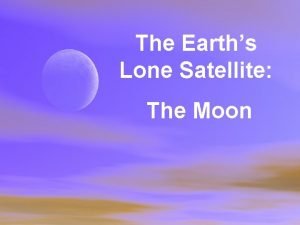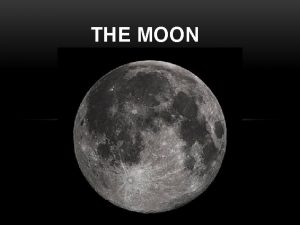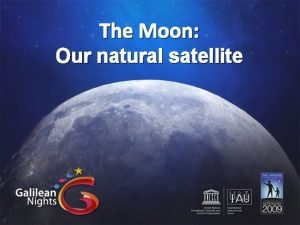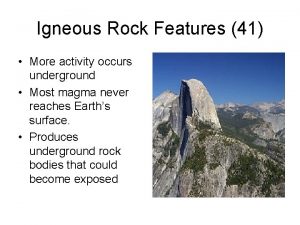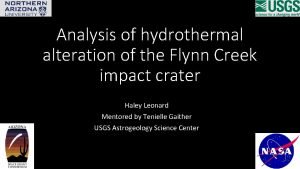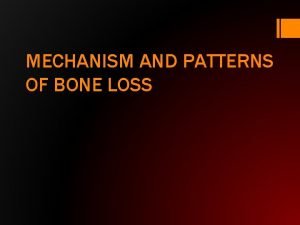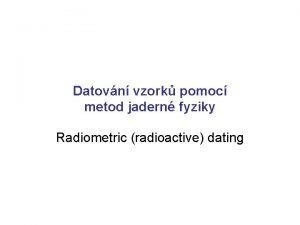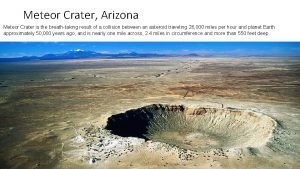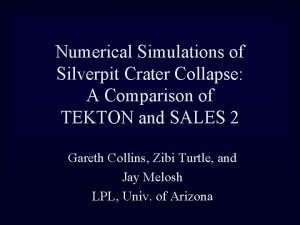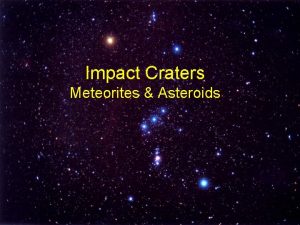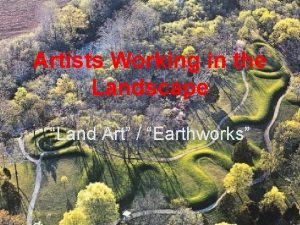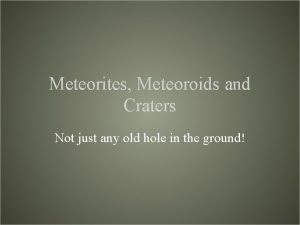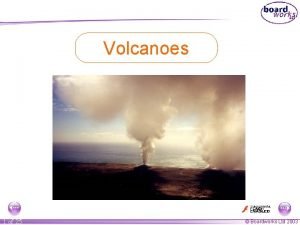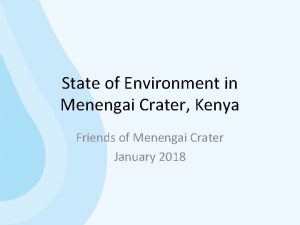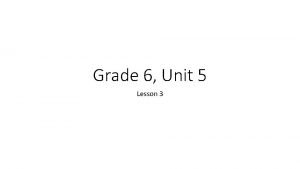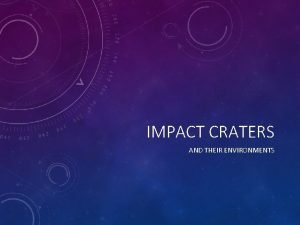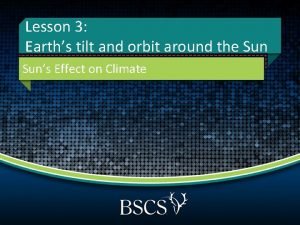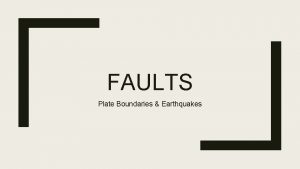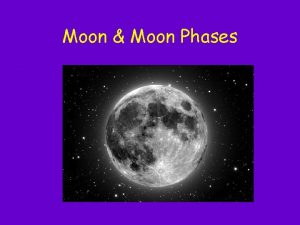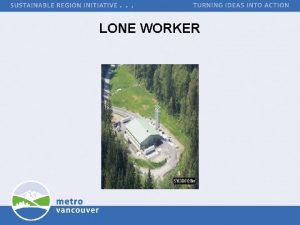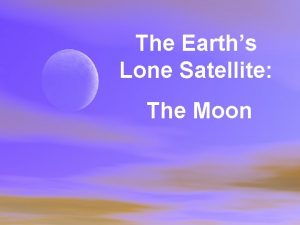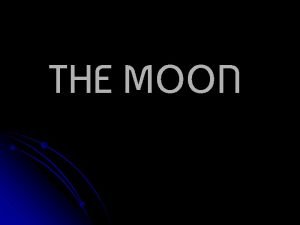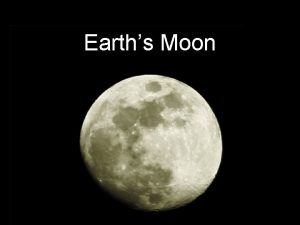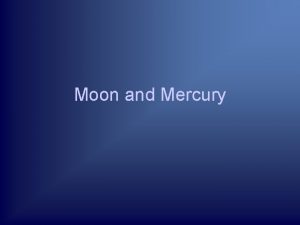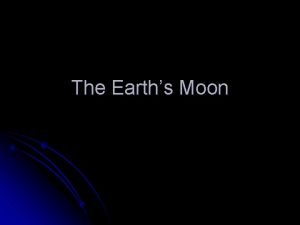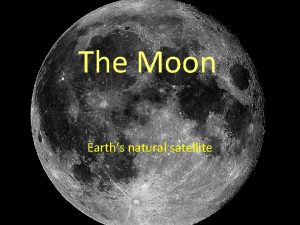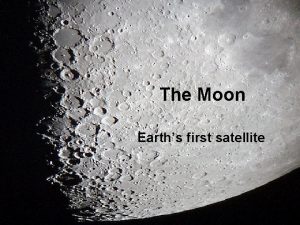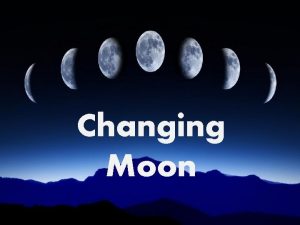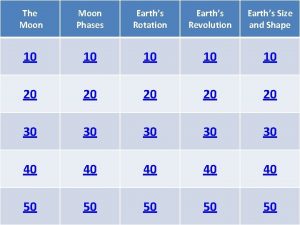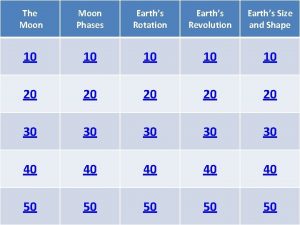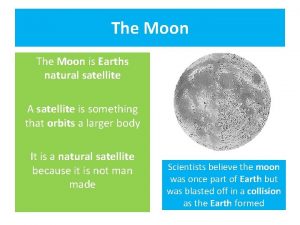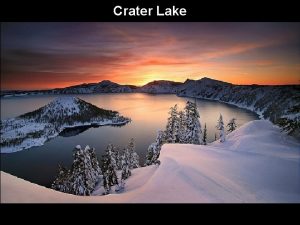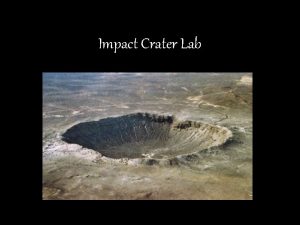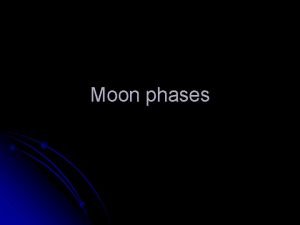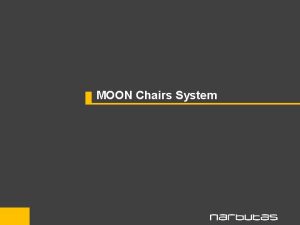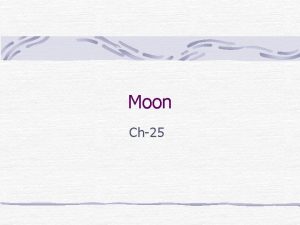The Earths Lone Satellite The Moon Copernicus Crater










































- Slides: 42

The Earth’s Lone Satellite: The Moon



Copernicus Crater

Kepler Crater

The most obvious feature on the Moon’s surface are its many craters. Most of the Moon’s craters are round, implying that they were formed from impacts by high-speed meteoroids. Craters include features such as central peaks, collapsed terrace walls, and ejecta blankets.

Close examination of moon rocks reveal tiny microcraters less than one millimeter in diameter.

The Moon’s surface also has large, dark gray plains called maria. Since these regions have few impact craters, the lunar surface here is relatively young compared with the lighter surrounding terrain.

From Earth, maria appear to be smooth regions on the lunar surface. However, close-up photographs reveal small craters and occasional cracks called rilles. CLOSE-UP VIEWS FROM A LUNAR ORBITER APOLLO 15 MISSION

A surprising find from lunar orbiters is that the side of the Moon facing away from the Earth has only one small mare, while the rest is covered with craters.

Missions to the Moon have revealed much about its history. An enormous boulder fractured while sliding down a mountain The Moon’s surface is covered with a layer of powdered rock called regolith.

Lunar Rocks from Different Regions MARE BASALT contains many holes, suggesting that gas was dissolved in the lava and solidified to create this rock. ANORTHOSITE from the highlands is an ancient rock believed to be part of the Moon’s original crust. IMPACT BRECCIAS are created from debris fused together under high temperature and pressure created by impacts of space debris with the lunar surface.

Seismic experiments revealed that the main regions of the Moon’s interior mimic those of the Earth, but in different proportions. Water ice may exist in the polar craters, where the energy received from the Sun is insufficient to melt it.

The similarity in materials making up the Earth and Moon suggest that the Moon may have been created from Earth material ejected after a collision with a large planetesimal. MOON EARTH This computer simulation shows how the Moon could have been formed in a collision between the Earth and a large planetesimal.


Lunar Geology Craters-formed by asteroids, meteoroids and comets l Impact craters l No volcanoes l Small volcanic domes l Channels/rilles- appear to have lava tubes l Lava plains=maria (Mare-seas)-dark features l Lunar highlands-bright features l

Lunar Geology Lunar soil-dust form impacts l South Pole…. . -400 degrees/ w/ water l Temperature range form 243 to -272 degrees l Lunar mountains are rims of craters l No atmosphere (gases hydrogen, helium, Neon, Argon l Rock l



Gravitational forces have locked the Moon into a synchronous rotation in which the Moon’s orbital period around the Earth is equal to the rotational period of its axis. As a result, the same side of the Moon always faces the Earth.

The Moon is spiraling away from the Earth at a rate of 3. 8 cm per year. (1 inch = 2. 5 cm) The energy given to the Moon comes from the Earth’s rotation, which is slowed in the process. Laser beams fired at the Moon bounce off reflectors placed by Apollo astronauts and return to Earth. By timing this process, we can determine the distance to the Moon within a few millimeters.

WHAT DID YOU THINK? Who was the first person to walk on the Moon and when did this event occur? l Neil Armstrong on July 20, 1969. l Do we see all parts of the Moon’s surface at some time throughout the lunar cycle? l No; because the Moon’s rotation around Earth is synchronous, we always see the same side. l Does the Moon rotate and, if so, how fast? l Yes, the Moon rotates at the same rate that it revolves around the Earth. l

Facts about the Moon The Moon is a satellite and only reflects light from the Sun. It does NOT provide any light on its own. l It is Earth’s closest neighbor in space, and it is roughly 240, 000 miles from the Earth most of the time. l It has a Nickel-Core, and there are three different theories that exist which try to explain the origin of Earth’s only satellite. l

Facts cont. l l The Moon “wobbles, ” a term called libration, which makes it possible for humans to see roughly 51% of the Moon’s surface. However, the Moon does have a “Dark Side” so to speak. There is a side of the Moon that we NEVER see without lunar visits or satellite mapping. The Moon has many different features, including mare (“seas” or lava-formed plains), terra (highlands), craters (created from asteroid and meteorite impacts), and mons (mountains).

Examples of Features l l l “Seas” – Mare Tranquillitatis “Sea of Tranquility” (where Apollo XI landed) Mare Serenitatis “Sea of Serenity” “Mons” – Montes Apenninus “Apennine Mts. ” like on Earth Montes Alpes “Alps Mts. ” like on Earth Craters – Archimedes, Copernicus, and Tycho (All large ones are named after famous dead scientists, scholars and artists. Small ones tend to have common first names. )

Four Theories about Moon’s Origin l Theory One is Nebular Contraction or Condensation Theory that says the Earth and Moon were produced or created at the same time in the same or close nebulas during the creation of the Solar System. l Theory Two is the Capture Theory, in which the Earth’s gravity pulled the Moon in while it was passing near Earth.

Theories cont. l Theory Three is the Fission Theory, in which the Moon split apart of the primordial Earth while it was forming and stayed close by due to Earth’s gravity. l Theory Four (the one scientists lean towards) is the Collision Theory in which an asteroid or something large in size hit the primordial Earth forcing back of the remnants (orbiting clouds of debris) soon clustered together over time to become our Moon.

l l l l l Apollo missions APOLLO LANDING SITES Apollo 11 — Mare Tranquillitatis Lunar Landing Time 4: 17: 40 p. m. EDT, July 20, 1969 Landing Site Coordinates 0. 67408° N latitude, 23. 47297° E longitude Apollo 12 — Oceanus Procellarum Lunar Landing Time 01: 54: 35 a. m. EST, November 19, 1969 Landing Site Coordinates 3. 01239° S latitude, 23. 42157° W longitude Apollo 14 — Fra Mauro Lunar Landing Time 4: 18 a. m. EST, February 5, 1971 Landing Site Coordinates 3. 64530° S latitude, 17. 47136° W longitude Apollo 15 — Hadley/Apennines Lunar Landing Time 6: 16 p. m. EDT, July 30, 1971 Landing Site Coordinates 26. 13222° N latitude, 3. 63386° E longitude Apollo 16 — Descartes Lunar Landing Time 9: 24 p. m. EST, April 20, 1972 Landing Site Coordinates 8. 97301° S latitude, 15. 49812° E longitude Apollo 17 — Taurus-Littrow Lunar Landing Time 19: 54: 57 GMT, December 11, 1972 Landing Site Coordinates 20. 19080° N latitude, 30. 77168° E longitude



Spring and Neap Tides Spring Tides: Neap Tides: These are the highest tides that occur on Earth. These are the tides that occur which are lower than usual. They occur during Full Moons and New Moons in the monthly Lunar Cycle. They occur during the First Quarter Moon and Last Quarter Moon phases. These tides are especially high whenever the Moon is at perigee in its annual rotation around the Earth. These tides are especially LOW whenever the Moon is at apogee in its annual rotation around the Earth.

The Moon Phases l Over the course a month, actually 29. 5 days, the Moon goes through its different phases. l Each phase will be shown and the day in the cycle that it appears. Please draw each phase, the day and name that is shown on the following slides.

Moon Phases l New Moon The Moon is in front of the Sun, and the “Dark Side of the Moon” receives the Sun’s light. Day 0 -1

l Waxing Crescent The Moon is backlit by the Sun as it approaches one quarter of its cycle completion. Days 2 -6

l First Quarter One quarter of the Lunar Cycle is complete, but only HALF of the Moon is lit. (Name indicates portion of cycle completed not amount of light shown!) Day 7. 4

l Waxing Gibbous The Moon is getting brighter and brighter as it is approaching Full Moon and it is positioning itself across from the Sun with the Earth in the middle. Days 8 -13

l Full Moon The Moon is halfway through its cycle. The Moon is fully-lit by the Sun, and it is directly across from the Sun with the Earth in the middle. Day 14. 8

l Waning Gibbous The Moon is starting to darken again. It is over halfway through its cycle. Days 15 -21

l Last Quarter The Moon is now three-fourths, 75%, through its cycle. It is in its “last quarter” before the New Moon repeats. Day 22. 1

l Waning Crescent The Moon is almost completely dark again. Less and less light is being shown, and the Moon repositions itself between the Earth and the Sun. Days 23 -28

l New Moon It’s Day 29. 5, and the New Moon reappears. The Cycle has officially ended and officially begins again.

Have you ever heard the saying… “Once in a Blue Moon”? That is actually a real phenomenon. During the course of a year, it is possible to have 13 Full Moons. In the case of a 13 -Full-Moon year, one month has two full moons. When a month has TWO FULL MOONS, the second Full Moon is called the Blue Moon!
 Copernicus crater
Copernicus crater Whats the name of earths moon
Whats the name of earths moon Whats earths moon called
Whats earths moon called Whats earths moon called
Whats earths moon called Home.hiwaay.net/ krcool/astro/moon/moon tides/
Home.hiwaay.net/ krcool/astro/moon/moon tides/ Duo servicekantoor
Duo servicekantoor Moons pattern
Moons pattern Which moon phase occurs directly before a new moon
Which moon phase occurs directly before a new moon Moon sister moon calendar
Moon sister moon calendar A whalebone that originally contained 200 grams
A whalebone that originally contained 200 grams Underground igneous rock bodies are called
Underground igneous rock bodies are called Flynn creek crater
Flynn creek crater Suprabony vs infrabony defect
Suprabony vs infrabony defect Meteor crater, arizona
Meteor crater, arizona Beaverhead crater
Beaverhead crater How was mount mazama formed
How was mount mazama formed Silverpit crater
Silverpit crater Bulbous bone contour
Bulbous bone contour Mistastin crater
Mistastin crater Roden crater
Roden crater Meteor crater, arizona
Meteor crater, arizona Vent and crater
Vent and crater Seborrheic dermatitis red spots on scalp
Seborrheic dermatitis red spots on scalp Menengai crater fire
Menengai crater fire Biggest crater on earth
Biggest crater on earth Shoemaker crater
Shoemaker crater Most common elements in the earth's crust
Most common elements in the earth's crust Earths early atmosphere contained
Earths early atmosphere contained Layers of the atmosphere definitions
Layers of the atmosphere definitions What does earths tilt do
What does earths tilt do Brown earths
Brown earths Earth layers foldable
Earth layers foldable Earths crust
Earths crust Earth layer foldable
Earth layer foldable Describe the true shape of earth's orbit
Describe the true shape of earth's orbit Earths boundaries
Earths boundaries Study of earth's physical features
Study of earth's physical features Basalt
Basalt Earths roation
Earths roation Earths interior
Earths interior Earths major crustal plates
Earths major crustal plates Earths 4 spheres
Earths 4 spheres Earth's honey fertilizer
Earth's honey fertilizer
